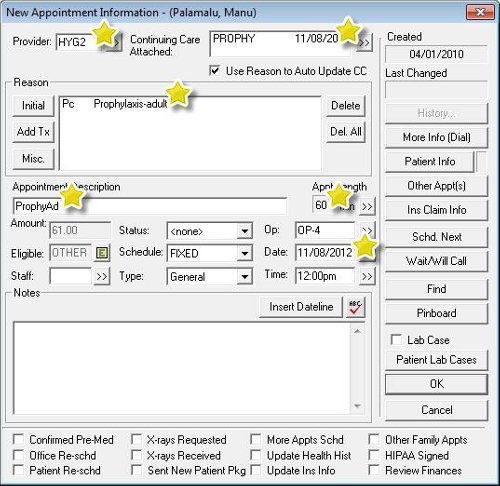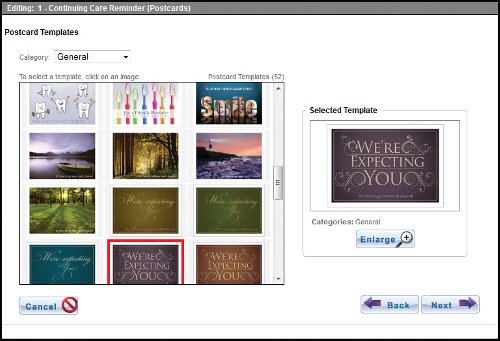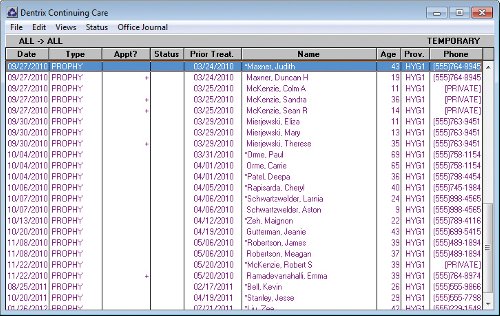Five Ways to Keep Your Patients Coming Back

Most practices spend a lot of time and money recruiting new patients. We give them good care and service while they’re in the office and then we let them go out the door without establishing a permanent relationship with them.
Studies show that fewer patients are seeking dental care today. But even with the increased competition, patient retention still only averages around 55%. We need to treat every patient as if keeping him or her coming back is our most important task. The following are five ways to get your continuing care program back on track.

Pre-book hygiene appointments
Tell patients that by scheduling their next appointment now, they can select a date and time that works best for them. If you’re using the Dentrix Appointment Book as designed, then you’ve got all the tools you need to make scheduling that next hygiene appointment a breeze. If today’s appointment has been scheduled for a continuing care reason, you can set the appointment complete and schedule the next appointment with only a few mouse clicks. Dentrix will create a new appointment for the patient using the same time, operatory, provider and continuing care reason using their new continuing care date as the appointment date.

Remind patients about scheduled appointments
By actively contacting patients before appointments, you can minimize no-shows. Even better, Dentrix can do the contacting for you. The Dentrix eCentral Communications Manager can send appointment reminder cards, emails and text messages to all your pre-booked patients. You just have to set up the correspondence intervals. Start by designing a dynamic “keep in touch” strategy. For example, two weeks before the pre-booked appointment, send patients an appointment reminder postcard. Follow up with an email reminder two days before the appointment. As a final reminder effort, two hours before the appointment, send a text message inviting patients to ask about a cosmetic service such as bleaching at their scheduled appointment.
While you’ll never fully eliminate last-minute cancellations and no-shows, with the right communication campaign you’ll get patients the information they need and let them know that you value your relationship with them.

Follow up with patients who left without pre-booking
Despite your best attempts, some patients will leave your office without pre-booking their next appointment. Luckily, however, Dentrix can help you quickly identify those patients that may need a little extra TLC by generating a continuing care list that shows patients who should have scheduled a hygiene appointment, but didn’t. Use the list to make phone calls. As you make contact, keep detailed notes about the phone call in the Office Journal to help you remember what happened on the call. The continuing care list is dynamic, so once you’ve scheduled a patient for an appointment, they’ll be automatically removed from your call list.

Reach out to patients who haven’t been in for a long time
If patients have put off treatment for a long time, they might feel embarrassed about how much time has passed. This is a critical time in your relationship with them. Reach out to these patients with an attitude that shows you don’t care what happened in the past, you want to see them again.
Start by sending out an email reminder that tells them you’ve missed them. Select a template in the Communication Manager that’s both friendly and inviting. Edit the text to say something like, “We’ve missed you. At Dentrix Dental Practice we want to make sure you have the best smile possible. We’ll be calling to see how we can best meet your oral health needs. Talk to you soon.” Once your emails have gone out, follow up with a phone call that encourages patients to schedule their hygiene appointment.

Keep track of continuing care statistics
You can see how well you’re doing at getting those appointments scheduled by running the Practice Advisor Report. The report shows you statistics for the continuing care visits you’ve completed and for patients with continuing care due. The CC Visits section of the report shows you visit data about the previous month, the current month and the year to date. The # of CC Patients Seen row shows the total number of patients that have been seen in the time period (prior month, month-to-date or year-to-date). You can see how many of those patients have their next appointment already scheduled by looking at the # of Patients Seen with Appt Scheduled row. (The graphical option shows you the # of Patients Seen with Appt Scheduled option as a bar graph to help you visualize the data.) Use the # of Patients Seen with Appt Scheduled number to quickly gauge how well you’re doing at keeping your patients active in your practice.
Learn more
To learn more about scheduling continuing care appointments, see the Scheduling Continuing Care Appointments and Setting a Continuing Care Appointment Complete topics in the Dentrix Help. To learn more about setting up Communications Manager campaigns, see the Sending Postcard Appointment Reminders (#58041) Sending Email Appointment Reminders (#58039), and Sending Text Message Appointment Reminders (#62956) articles in the Dentrix Resource Center. To learn more about generating a continuing care list, see the Continuing Care List View Options topic in the Dentrix Help. To learn more about customizing an email template, see Editing Email Templates in the eCentral Help. To learn more about the Practice Advisor Report, see the Dentrix G5 Reports Reference.
Screenshots:

Figure 1.Dentrix makes pre-booking easy. When you set the current hygiene appointment complete, Dentrix prompts you to schedule the next appointment.

Figure 2.With the Communication Manager you can stay in touch with your patients who have pre-appointed by sending postcards, emails and text message reminders at staggered intervals.

Figure 3.With the Continuing Care List you can generate an interactive report of patients who might have fallen through the cracks.
.jpg)
Figure 4.The Communication Manager allows you to customize and send emails to patients who are overdue for their continuing care visits.

Figure 5.Keep track of how you’re doing with your new and improved continuing care program by monitoring the Continuing Care section of the Practice Advisor Report.
Author: May Wescott
Published: 07/25/2012

 Contact Us
Contact Us Phone:
Phone:  Email
Email Request Demo
Request Demo